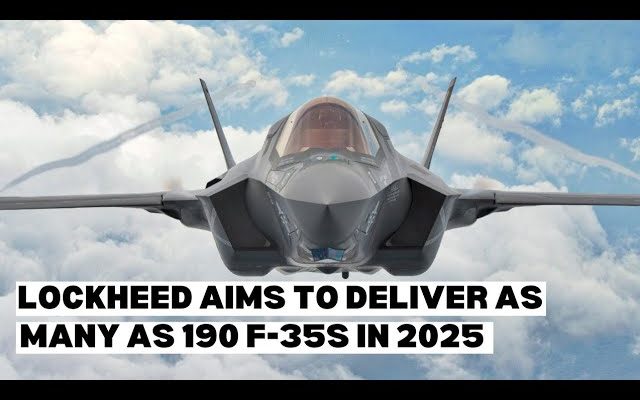Lockheed Martin, one of the world’s leading aerospace and defense contractors, has set an ambitious target for 2025, aiming to deliver up to 190 F-35 fighter jets. This goal marks a significant ramp-up from previous years and highlights the growing demand for the fifth-generation fighter jet among both U.S. and international customers. The company’s delivery expectations come at a critical juncture for the F-35 program, as it continues to expand its global footprint and solidify its role in modern air forces worldwide.
A Record-Breaking Goal
In 2024, Lockheed delivered approximately 110 F-35 jets, a solid performance that helped bolster the aircraft’s presence in various air forces across the globe. However, the company’s 2025 target of 190 units represents a 70% increase in deliveries, a clear indication of the demand for the F-35’s capabilities. The aircraft, which features advanced stealth, sensor fusion, and versatility, has become a key component of modern air combat strategies, appealing to a growing list of countries.
Lockheed has made substantial progress in streamlining the F-35’s production, aiming to improve the efficiency of its assembly lines and reduce costs. This production ramp-up is critical for meeting the needs of nations that are keen to modernize their air fleets with state-of-the-art aircraft. These jets are not only seen as essential for national security but also as critical components of international defense cooperation, with the U.S. leading a coalition of allies operating the F-35.
The F-35 Program’s Global Reach
The F-35 program is one of the most significant military procurement efforts in history. The aircraft is offered in three variants—F-35A (conventional takeoff and landing), F-35B (short takeoff and vertical landing), and F-35C (carrier-based)—to meet the varied needs of different military branches. Its versatility and stealth capabilities make it particularly suited for penetrating contested airspace and executing precision strikes, which are vital in modern warfare scenarios.
Countries around the world, from the U.S. to European nations and even Australia, have made significant investments in the F-35. For instance, Australia is committing to an additional $3 billion for F-35 procurement as part of a broader effort to modernize its defense strategy. The aircraft’s global sales are also supported by partnerships with NATO allies, enhancing interoperability between forces.
Challenges and Supply Chain Considerations
Achieving the target of 190 deliveries in 2025 will not be without challenges. Lockheed Martin has faced difficulties in the past related to production delays, supply chain issues, and technical refinements needed to address emerging needs. The company has been working to optimize its production lines and enhance the efficiency of its suppliers to ensure that the ramp-up is both sustainable and on schedule. Ensuring the timely delivery of key components, such as advanced avionics and engines, remains a priority to avoid any disruptions to the planned deliveries.
Moreover, the U.S. Department of Defense and Congress have periodically adjusted the number of F-35s they plan to procure, which can affect Lockheed’s production schedule. In 2024, a reduction in the number of jets slated for delivery was noted in the defense authorization bill, reflecting the balancing act between rapid procurement and long-term program health.
Conclusion
Lockheed Martin’s target to deliver 190 F-35s in 2025 is an ambitious yet achievable goal, reflecting both the growing global demand for advanced air combat capabilities and the company’s commitment to modernizing defense forces worldwide. As more nations invest in these cutting-edge jets, the F-35 continues to solidify its place as a cornerstone of modern military aviation. Despite production challenges, Lockheed’s efforts to ramp up deliveries demonstrate its ability to meet international demand, enhancing the global defense landscape for years to come.



